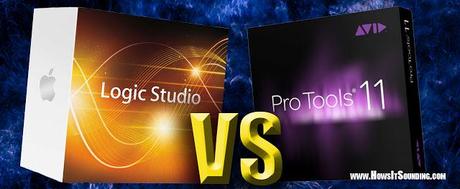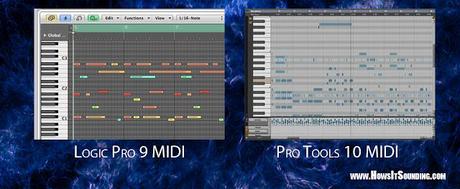In the world of audio, there are quite a few digital audio workstations (DAWs) to choose from. However, unless you are set on making phat beats with FL Studio, then you are aware that the two biggest players in the DAW world are Apple’s Logic Pro, and Avid’s Pro Tools. With the onset of Pro Tools turning things up to eleven, and more unconfirmed rumors about Logic Pro 10, it’s only appropriate to visit the Ford VS Chevy battle of the audio world: Logic VS Pro Tools.
 Share this blog for cheesy blue explosive versus pictures!
Share this blog for cheesy blue explosive versus pictures!Currently, Apple is on its long running Logic Pro 9. Avid’s Pro Tools is currently on version 10, but is to be rolling out version 11 in the near future (Pro Tools 10 will be used for comparison unless stated otherwise). Both are quite popular in the industry. Which one is best? This can seem like a loaded question, unfair, or inapplicable to some. GearSlutzhas a heated forum thread about this. There are simply certain things that each does better than the other.
MIDILet’s take music composition and MIDI into account. Logic, in my opinion, is a much better platform for this. Out of the box, Logic has better sounding virtual instruments that seem to be much more user friendly to manipulate and tweak. Quantization is easy to get right, instrument selection is vast, and individual note manipulation seems easier. The few times I worked with the built in MIDI in Pro Tools, I felt an 80s synthesizer could sound better.

Basic RecordingSometimes you may just want to record audio into one of these DAWs with a microphone. They both do this very well. They both seem to have one extra step that slows things down. In Pro Tools, you have to physically set everything up in the I/O setup. There is nothing wrong with this. If anything, it’s better because it allows the user complete control. For Logic, the step I have been annoyed by is the fact that the metronome is automatically on when you first record. Again, nothing big.
This big factor is an interface. Logic seems to be fairer to those who are budget minded. Even if you have a cheap USB microphone, or a TRS mic with a preamp, you can’t use it in Pro Tools without an interface. With Logic, you just plug it into your computer, and you’re good to go. Now, there is nothing wrong with needing an interface, but for those who can’t really afford an interface right away, this can be a deciding factor.
Advanced (Session) RecordingNow if you have an interface and multiple microphones, Pro Tools is the hands down winner. Set up your tracks, arm them, and press your numeric three, and you’re good to go. Recording a large multi-track session is just something Pro Tools will get right every time. Miss something in the recording? Nudge the playhead back, and press three again. Which brings me to the next point…
Keyboard UseBoth DAWs make use of keyboard shortcuts. I think the Pro Tools’ keyboard shortcuts are laid out much better. It is unbelievably easy and crazy how fast you can get around in Pro Tools if you know the key commands. Logic is a bit behind on this. However, you can fly around on either just as fast as the other with practice. Still, Pro Tools wins.
Sound EditingPro Tools again is a winner here. Is again comes down to the ease of navigation and sample accurate capabilities. I really love the nudge feature. When I attempt to do sound effect editing (or audio editing in general) in Logic, I find myself guessing where I should cut something. It seems when you zoom into a track in Logic, things get even more confusing to look at then the rounded corner tracks you see when you zoom out. With Pro Tools, you get a box of a track, and when you zoom in, you can see that exact sample you are on. You can slice the track confidently where you want.
Bits and BouncingBoth of these topic may be huge to some, but I’ll throw them together in a short section since Pro Tools is about to change both of these. Logic has been running in 64 bit, and has offline bouncing. Pro Tools has been stuck in 32, and you can only do real time bouncing. Let’s face it: for most, the difference between 32 bit and 64 bit means nothing, so let’s move on.
I love Logic’s offline bouncing. Sure there is nothing wrong with a final quality control check of a realtime bounce, but sometimes you just want that quick bounce. As mentioned, Pro Tools 11 will have both offline bouncing and be running in 64 bit. But now because of this switch to 64 bit, all of the plugins you have been using for version 10 and previous go bye-bye. So Pro Tools takes a hit there. For more information about that, click here.

ConclusionThere are tons of things that can be discussed. In an effort to not have you click away if you have not already, I’ll sum it up:
For MIDI and Music Composition: Logic Pro WinsFor Audio Recording and Editing: Pro Tools Wins
Some of you may disagree, and some may not agree with all of my opinions, and some may think I left some important things out. However, based off of my experience, and “stock for stock” (or directly out of the box) performance, the above winning seems to be accurate. Whichever you think may be better may just depend on which you have, or what you do in the audio world. So, which so you think is better?

